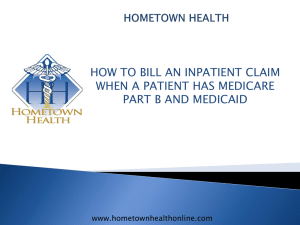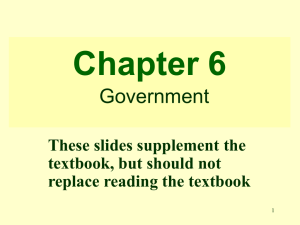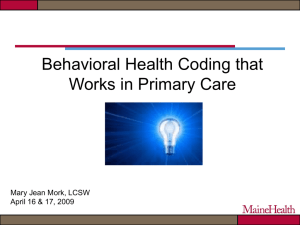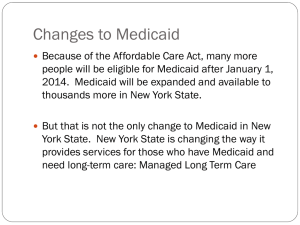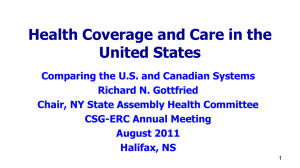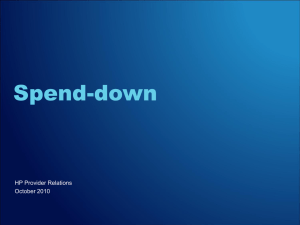.ppt - The Actors Fund
advertisement
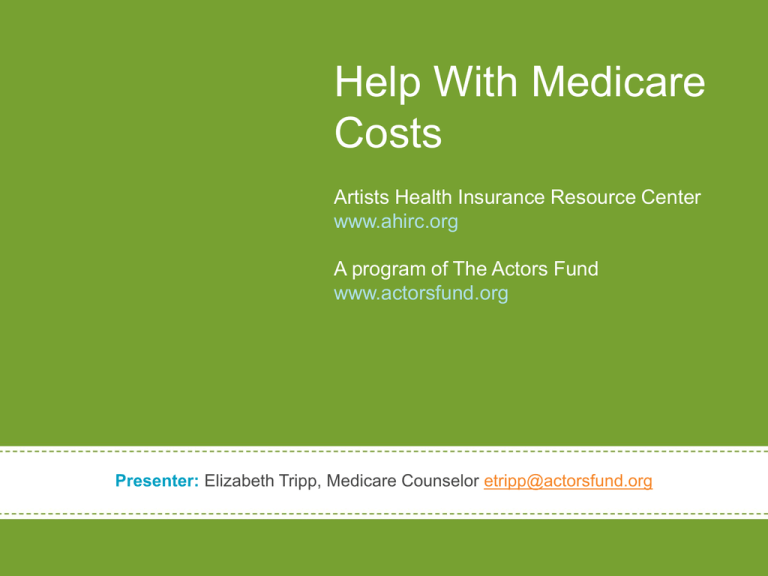
Health Insurance, Help With Medicare Health Costs Care Reform and Resources Artists Health Insurance Resource Center inwww.ahirc.org Chicago A program of The Actors Fund www.actorsfund.org Dancers’ Health Insurance Resource Center A program of The Actors Fund with support from The Doris Duke Foundation Presenter: Presenter: Jim Elizabeth Brown, Director Tripp, Medicare of HealthCounselor Services,etripp@actorsfund.org jbrown@actorsfund.org. Introduction This presentation was designed to help you understand: • Programs that help cover costs associated with Medicare • Whether you are eligible for any of these programs • How to apply for them What does this tutorial cover? The programs we will cover today are: • • • • • • Medicaid Medicaid with spend-down Medicare Savings Programs Extra Help State Pharmacy Assistance Programs (SPAPs) Pharmaceutical Assistance Programs (also called Patient Assistance Programs) What is Medicaid? Medicaid helps some people with limited income and resources with medical costs. People who qualify for both Medicare and Medicaid are called “dual eligibles.” Medicare is their primary insurance, and Medicaid pays many of the costs that Medicare does not. These costs include premiums, coinsurance, co-payments and deductibles. Medicaid also offers benefits not normally covered by Medicare, like nursing home care and personal care services. If you qualify for Medicaid in your state, you automatically qualify for Extra Help, a program that helps pay your Medicare Prescription Drug coverage (Part D). Am I eligible for Medicaid? Every state uses financial eligibility guidelines to determine whether you qualify for Medicaid. Generally, your income and assets must be below a certain amount to qualify, but this amount varies from state to state. Use your state’s Medical Assistance website to find the income guidelines for where you live. How do I apply for Medicaid? You may be able to apply for Medicaid in-person at a Medicaid office or community organization, online, by mail, or even over the phone in some circumstances. Again, check with your state’s Medicaid site to see your options. What is Medicaid "spend down"? If your income is over the Medicaid eligibility limit, you may still be eligible under Medicaid “spend-down” rules. The spend-down is intended to help people whose income is too high to qualify for Medicaid, but who have significant medial expenses that reduce their income. How is it calculated? The spend-down (also called the medically needy process, or excess income program) allows you to “spend down”, or subtract, your medical expenses from your income to become eligible for Medicaid. Your spenddown amount will be the difference between your income and the Medicaid eligibility limit over a certain period of time. To be eligible as “medically needy”, your measurable resources have to be under the resource amount allowed in your state. Example: If the income limit for Medicaid is $800 per month, and your income is $920, your monthly spend-down amount would be $120. $920 income -$800Medicaid income limit = $120 spend-down, or the amount of your income that exceeds the Medicaid limit How does the "spend-down" process work? In some states, the spend down amount is treated like a deductible – after you pay the spend-down amount for medical co-pays out of your own pocket, Medicaid will cover the rest of your expenses. In other states, you pay a monthly premium directly to Medicaid for the amount that your income is over your state’s Medicaid spend-down level. Your state will determine how long a period of time you will qualify for a spend-down. You may be required you to submit your medical bills to Medicaid to prove the sum of medical expenses. You can apply for a spend-down when you apply for Medicaid. What are Medicare Savings Programs? If you don’t qualify for Medicaid or the spend-down program, you may still be able to get help paying some of your out-of-pocket expenses. Medicare Savings Programs (MSPs) help pay your Medicare costs if you have limited finances. There are three main programs, as well as a special program for people who are disabled and are working, and each has different income eligibility limits. Medicare Savings Programs can pay premiums, deductibles, coinsurance, and co-payments. Am I eligible for a Medicare Savings Program? Eligibility for MSPs is based on a percentage of the Federal Poverty level (FPL). For a single person, 100% of the Federal Poverty Level is equal to an annual income of $11,490. For a couple, it’s equal to $15,510. See the following slide for the income limits for each program. Medicare and Medicaid Enrollee Category Income Eligibility Level Resource Standards What the Program Pays For Qualified Medicare Beneficiary (QMB) 100% FPL ($11,490 individual, $15,510 married couple) $6,680/ individual, $10,020/ couple Part A premiums, Part B premiums, deductibles/coinsurance/co-payments Specified Low-Income Medicare Beneficiary (SLMB) 120% FPL ($13,788/ individual, $18,612/couple) $6,680/ individual, $10,020/ couple Part B premiums only Qualified Individual (QI) 135% FPL ($15,511/ individual, $20,938/couple) $6,680/ individual, $10,020/ couple Part B premiums only Qualified Disabled Working Individual (QDW) 200% FPL ($22,980/ individual, $31,020/couple) $4,000/ individual, $6,000/ couple Part A premiums only How can I apply for an MSP? Medicare Savings Programs are administered by a state’s Medicaid Program. Click here to find your state’s MSP, which has information about eligibility, applications, and what documentation you will need to apply. What is Extra Help? Extra Help is a program that helps people with limited income and resources pay for some or most of their Medicare prescription drug costs. Extra Help works with Medicare Part D plans. If you qualify for Extra Help and join a Medicare drug plan, you’ll: • Get help paying your Medicare drug plan’s monthly premium, yearly deductible, coinsurance, and co-payments • Have no coverage gap • Have no late enrollment penalty Do I qualify for Extra Help? • You may qualify for Extra Help if your yearly income and resources are below these limits in 2013: • For a single person— your annual income must be less than $17,235 and resources less than $13,300 • For a married person living with a spouse and no other dependants—your annual income must be less than $23,265 and resources less than $26,580. How do I apply for Extra Help? You automatically qualify for Extra Help if you have Medicare and also: • Have full Medicaid coverage • Are enrolled in a Medicare Savings Programs • Get Supplemental Security Income (SSI) benefits • If you don’t automatically qualify, you can fill out an application with Social Security online. • You can call Social Security for help with the application at 1-800772-1213. What documents will I need to apply for Extra Help? To fill out the application, you will need access to: • Your Social Security card; • Bank account statements, including checking, savings, and certificates of deposit; • Individual Retirement Accounts (IRA), stocks, bonds, savings bonds (including book entry securities*), mutual funds, other investment statements; • Tax returns; • Payroll slips; and • Your most recent Social Security benefits award letters or statements for Railroad Retirement benefits, Veterans benefits, pensions and annuities. What counts as a resource or asset? Countable resources include: • Money in a checking or savings account • Stocks • Bonds Countable resources don't include: • Your home • One car • Burial plot • Up to $1,500 for burial expenses if you have put that money aside • Furniture • Other household and personal items What are State Pharmacy Assistance Programs (SPAPs)? State Pharmacy Assistance Programs help people pay for prescription drugs based on financial need, age, or medical condition. Each SPAP makes its own rules on how to provide drug coverage to its members. Many states coordinate their SPAPs with Medicare’s drug benefit (Part D). Your SPAP may help pay for your Part D plan’s premium, deductible, copayments, and coverage gap. Some SPAPs only give you coverage during your Part D plan’s coverage gap or “donut hole.” Find your SPAP here. What are Pharmaceutical Assistance Programs? Pharmaceutical Assistance Programs provide low-cost or free drugs to people with low incomes. While many PAPs will not accept people with Part D plans, some do. Medicare.gov has a great tool for finding PAPs specifically for your needs. Click here to enter the name of the prescription that you need help paying for to see if there are any PAPs that will assist with the cost. For other tips on saving money on prescription drugs, see our tutorial “10 Ways to Get Medications Discounted or Free”. Additional Resources This tutorial was designed to educate you on the programs that may help you with your Medicare out-of-pocket costs. For more detailed information on Medicare, visit: www.medicare.gov www.Medicareinteractive.org Glossary • • • • • • • Co-insurance – the amount you pay for your portion of medical services, usually expressed as a percentage. For example, Part B has a 20% co-insurance rate. Medicare pays 80% of the cost of a covered service, and you are responsible for 20%. Co-pay – a flat dollar amount paid for a medical service, such as an office visit or prescriptions. Deductible - The amount you must pay for health care or prescriptions before Original Medicare, your prescription drug plan, or your other insurance begins to pay. Extra Help - A Medicare program to help people with limited income and resources pay Medicare prescription drug plan costs, such as premiums, deductibles, and coinsurance. Medicaid - a public health insurance program for individuals and families with low incomes and resources. It is jointly funded by states and the federal government, and is managed by the states. Among the groups of people served by Medicaid are eligible low-income parents, children, seniors, and people with disabilities. Medicaid with spend-down – a program intended to help people whose income is too high to qualify for Medicaid, but who have significant medial expenses that reduce their income. Medicare Savings Programs – Four programs that help people with limited income and resources cover their out-of-pocket Medicare expenses. Glossary, cont'd – • • • • Qualified Medicare Beneficiary (QMB) Program—Helps pay for Part A and/or Part B premiums, deductibles, coinsurance, and copayments. – Specified Low-Income Medicare Beneficiary (SLMB) Program - Helps pay Part B premiums only. – Qualifying Individual (QI) Program—Helps pay Part B premiums only. You must apply every year for QI benefits and the applications are granted on a first-come first-served basis. – Qualified Disabled and Working Individuals (QDWI) Program - Helps pay Part A premiums only. You may qualify for this program if you have a disability and are working. Out-of-pocket expense - medical expenses that are not covered by insurance and are paid for directly by the individual. Pharmaceutical Assistance Programs (also called Patient Assistance Programs) assistance programs for people with Medicare drug coverage who meet certain requirements offered by major drug manufacturers Premium - The periodic payment to Medicare, an insurance company, or a health care plan for health or prescription drug coverage. State Pharmacy Assistance Programs (SPAPs) – state-run programs that help certain people pay for prescription drugs based on financial need, age, or medical condition. Each SPAP makes its own rules on how to provide drug coverage to its members.
